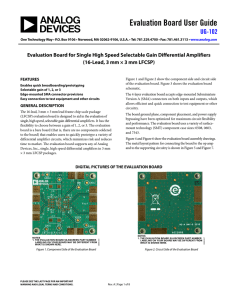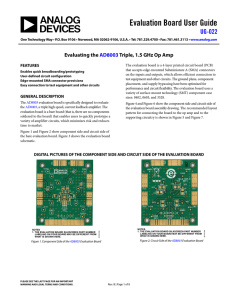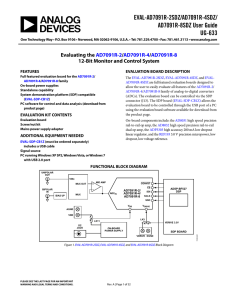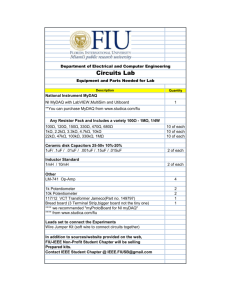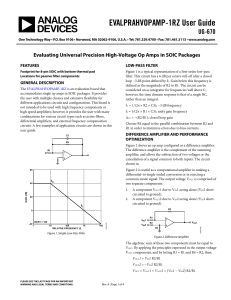Evaluation Board User Guide UG-200
advertisement
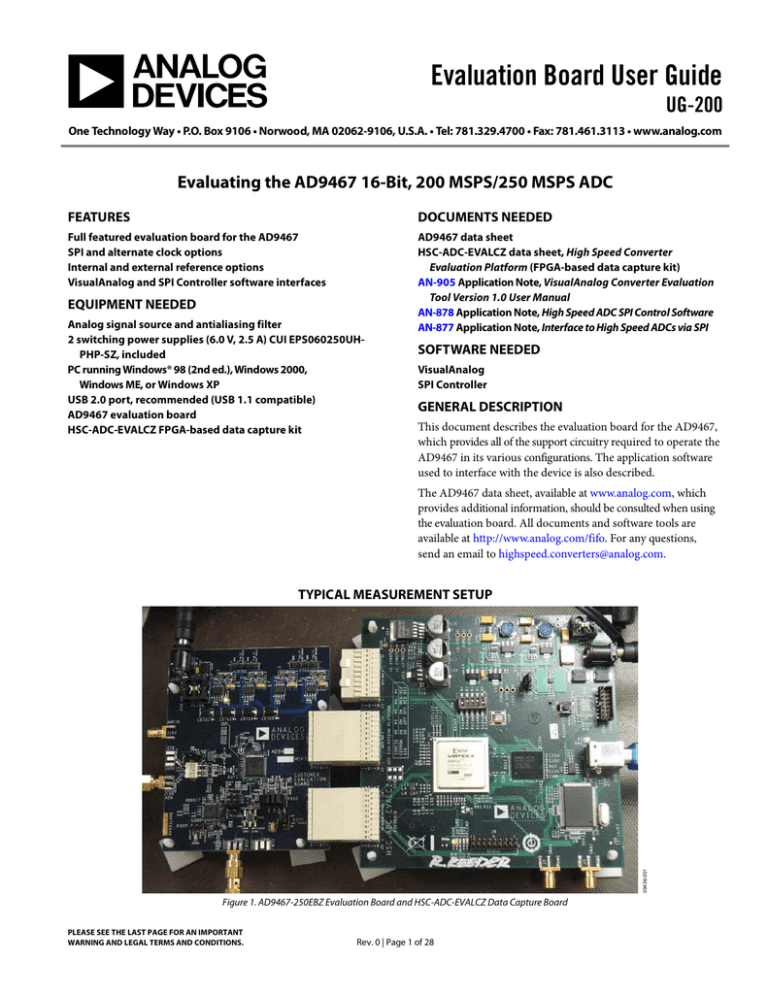
Evaluation Board User Guide UG-200 One Technology Way • P.O. Box 9106 • Norwood, MA 02062-9106, U.S.A. • Tel: 781.329.4700 • Fax: 781.461.3113 • www.analog.com Evaluating the AD9467 16-Bit, 200 MSPS/250 MSPS ADC FEATURES DOCUMENTS NEEDED Full featured evaluation board for the AD9467 SPI and alternate clock options Internal and external reference options VisualAnalog and SPI Controller software interfaces AD9467 data sheet HSC-ADC-EVALCZ data sheet, High Speed Converter Evaluation Platform (FPGA-based data capture kit) AN-905 Application Note, VisualAnalog Converter Evaluation Tool Version 1.0 User Manual AN-878 Application Note, High Speed ADC SPI Control Software AN-877 Application Note, Interface to High Speed ADCs via SPI EQUIPMENT NEEDED Analog signal source and antialiasing filter 2 switching power supplies (6.0 V, 2.5 A) CUI EPS060250UHPHP-SZ, included PC running Windows® 98 (2nd ed.), Windows 2000, Windows ME, or Windows XP USB 2.0 port, recommended (USB 1.1 compatible) AD9467 evaluation board HSC-ADC-EVALCZ FPGA-based data capture kit SOFTWARE NEEDED VisualAnalog SPI Controller GENERAL DESCRIPTION This document describes the evaluation board for the AD9467, which provides all of the support circuitry required to operate the AD9467 in its various configurations. The application software used to interface with the device is also described. The AD9467 data sheet, available at www.analog.com, which provides additional information, should be consulted when using the evaluation board. All documents and software tools are available at http://www.analog.com/fifo. For any questions, send an email to highspeed.converters@analog.com. 09436-001 TYPICAL MEASUREMENT SETUP Figure 1. AD9467-250EBZ Evaluation Board and HSC-ADC-EVALCZ Data Capture Board PLEASE SEE THE LAST PAGE FOR AN IMPORTANT WARNING AND LEGAL TERMS AND CONDITIONS. Rev. 0 | Page 1 of 28 UG-200 Evaluation Board User Guide TABLE OF CONTENTS Features .............................................................................................. 1 Input Signals...................................................................................3 Equipment Needed ........................................................................... 1 Output Signals ...............................................................................3 Documents Needed .......................................................................... 1 Default Operation and Jumper Selection Settings ....................5 Software Needed ............................................................................... 1 Evaluation Board Software Quick Start Procedures .....................6 General Description ......................................................................... 1 Configuring the Board .................................................................6 Typical Measurement Setup ............................................................ 1 Using the Software for Testing.....................................................6 Revision History ............................................................................... 2 Evaluation Board Schematics and Artwork ................................ 10 Evaluation Board Hardware ............................................................ 3 Ordering Information .................................................................... 25 Power Supplies .............................................................................. 3 Bill of Materials ........................................................................... 25 REVISION HISTORY 10/10—Revision 0: Initial Version Rev. 0 | Page 2 of 28 Evaluation Board User Guide UG-200 EVALUATION BOARD HARDWARE The AD9467 evaluation board provides all of the support circuitry required to operate the AD9467 in its various modes and configurations. Figure 2 shows the typical bench characterization setup used to evaluate the performance of the AD9467. It is critical that the signal sources used for the analog input and clock have very low phase noise (<1 ps rms jitter) to realize the optimum performance of the signal chain. Proper filtering of the analog input signal to remove harmonics and lower the integrated or broadband noise at the input is necessary to achieve the specified noise performance (see the AD9467 data sheet). See the Evaluation Board Software Quick Start Procedures section to get started and Figure 17 to Figure 31 for the complete schematics and layout diagrams that demonstrate the routing and grounding techniques that should be applied at the system level. POWER SUPPLIES This evaluation board comes with a wall-mountable switching power supply that provides a 6 V, 2.5 A maximum output. Connect the supply to the rated 100 V ac to 240 V ac wall outlet at 47 Hz to 63 Hz. The other end is a 2.1 mm inner diameter jack that connects to the PCB at P700. Once on the PC board, the 6 V supply is fused and conditioned before connecting to low dropout linear regulators that supply the proper bias to each of the various sections on the board. When operating the evaluation board in a nondefault condition, E704, E705, E706, E707 can be removed to disconnect the switching power supply. This enables the user to bias each section of the board individually. Use P700 and P701 to connect a different supply for each section. At least one 1.8 V supply is needed with a 1 A current capability for 1.8 V AVDD1 and 1.8 V DRVDD; however, it is recommended that separate supplies be used for both analog and digital domains. An additional supply is also required to supply 3.3 V to the DUT, 3.3 V AVDD2. This should also have a 1 A current capability. To operate the evaluation board using the SPI and alternate clock and amplifier options, a separate 3.3 V analog supply is needed in addition to the other supplies. The 3.3 V supply, or 3.3 V 3P3V_AVDD, should have a 1 A current capability. INPUT SIGNALS When connecting the ADC clock and analog source, use clean signal generators with low phase noise, such as Rohde & Schwarz SMA or HP8644B signal generators or the equivalent. Use a 1 m shielded, RG-58, 50 Ω coaxial cable for making connections to the evaluation board. Enter the desired frequency and amplitude (refer to the specifications in the AD9467 data sheet). If a different or external ADC clock source is desired, follow the instructions in the Clock Circuitry section or use the on-board crystal oscillator, Y200. Typically, most Analog Devices, Inc., evaluation boards can accept ~2.8 V p-p or 13 dBm sine wave input for the clock. When connecting the analog input source, it is recommended to use a multipole, narrow-band band-pass filter with 50 Ω terminations. Analog Devices uses TTE and K&L Microwave, Inc., band-pass filters. The filter should be connected directly to the evaluation board. OUTPUT SIGNALS The default setup uses the FIFO5 high speed, dual-channel FIFO data capture board (HSC-ADC-EVALCZ). For more information on this board and its optional settings, visit http://www.analog.com/fifo. Rev. 0 | Page 3 of 28 UG-200 Evaluation Board User Guide WALL OUTLET 100V TO 240V AC 47Hz TO 63Hz SWITCHING POWER SUPPLY SWITCHING POWER SUPPLY ANALOG INPUT SIGNAL SYNTHESIZER PC RUNNING ADC ANALYZER OR VisualAnalog USER SOFTWARE 09436-002 CLOCK INPUT SIGNAL SYNTHESIZER Figure 2. Evaluation Board Connection Rev. 0 | Page 4 of 28 Evaluation Board User Guide UG-200 Clock Circuitry DEFAULT OPERATION AND JUMPER SELECTION SETTINGS This section explains the default and optional settings or modes allowed on the evaluation board for the AD9467. Power Circuitry Connect the switching power supply that is supplied in the evaluation kit between a rated 100 V ac to 240 V ac wall outlet at 47 Hz to 63 Hz and P700. Analog Input Front-End Circuit The evaluation board is set up for single-ended analog input connection with an optimum 50 Ω impedance match of 350 MHz of bandwidth. For a different bandwidth response, the input network needs to be changed or modified. XVREF XVREF is set to 1.25 V. This causes the ADC to operate with the default internal reference in the 2.5 V p-p full-scale range. A separate external reference option using the ADR130 is also included on the evaluation board. Populate R400 with a 0 Ω resistor. Note that ADC full-scale ranges from 2.0 V p-p to 2.5 V p-p are supported by the AD9467. The default clock input circuitry is derived from a simple transformer-coupled circuit using a high bandwidth 1:1 impedance ratio transformer (T201) that adds a very low amount of jitter to the clock path. The clock input is 50 Ω terminated and ac-coupled to handle single-ended sine wave types of inputs. The transformer converts the single-ended input to a differential signal that is clipped before entering the ADC clock inputs. The evaluation board can be set up to be clocked from the crystal oscillator, Y200. This oscillator is a low phase noise oscillator from Vectron (VCC6-QCD-250M000). If this clock source is desired, install C205 and C206 and remove C202. Jumper P200 is used to disable the oscillator from running. A differential LVPECL or LVDS clock driver can also be used to clock the ADC input using the AD9517 (U300). Populate C304, C305, C306, and C307 with 0.1 µF capacitors for one drive option or the other and remove C209 and C210 to disconnect the default clock path inputs. The AD9517 has many SPI-selectable options that are set to a default mode of operation. Consult the AD9517 data sheet for more information about these and other options. Dx+, Dx− If an alternative data capture method to the setup shown in Figure 2 is used, optional receiver terminations, R500 to R509, can be installed next to the high speed backplane connector, P502. Rev. 0 | Page 5 of 28 UG-200 Evaluation Board User Guide EVALUATION BOARD SOFTWARE QUICK START PROCEDURES This section provides quick start procedures for using the AD9467, either on the evaluation board or at the system level design. Both the default and optional settings are described. CONFIGURING THE BOARD 3. 4. 5. 6. 7. Figure 3. VisualAnalog, New Canvas Dialog Box 2. If a different program is desired, follow Step 3. USING THE SOFTWARE FOR TESTING Figure 4. VisualAnalog, New Canvas Message Box Setting Up the ADC Data Capture 3. After configuring the evaluation board, set up the ADC data capture block using the following steps: 1. After the template is selected, a message box opens, asking if the default configuration can be used to program the FPGA (see Figure 4). Click Yes, and the window closes. 09436-004 2. Connect the evaluation board and the HSC-ADC-EVALCZ as shown in Figure 1 and Figure 2. Connect one 6 V, 2.5 A switching power supply (such as the CUI, Inc., EPS060250UH-PHP-SZ included) to the evaluation board. Connect one 6 V, 2.5 A switching power supply (such as the CUI EPS060250UH-PHP-SZ included) to the HSCADC-EVALCZ board. Connect the USB cable to J6 on the HSC-ADC-EVALCZ board to the PC. On the evaluation board, place jumpers on all four pin pairs of P600 to connect the SPI bus. On the evaluation board, ensure that P200 is jumpered to the off setting to use the on-board 250 MHz Vectron VCC6 oscillator. On the evaluation board, use a clean signal generator with low phase noise to provide an input signal to the desired channel. Use a 1 m, shielded, RG-58, 50 Ω coaxial cable to connect the signal generator. For best results, use a narrow-band band-pass filter with 50 Ω terminations and an appropriate center frequency. (Analog Devices uses TTE, Allen Avionics, and K&L band-pass filters.) Open VisualAnalog® on a PC. AD9467 should be listed in the status bar of the New Canvas window. Select the template that corresponds to the type of testing to be performed (see Figure 3). To view different channels or change features to settings other than the default settings, click the Expand Display button located on the top right corner of the VisualAnalog window, as shown in Figure 5 and Figure 6. This process is described in the AN-905 Application Note, VisualAnalog Converter Evaluation Tool Version 1.0 User Manual. Once you are finished, click the Collapse Display button. EXPAND DISPLAY BUTTON Figure 5. VisualAnalog Window Toolbar, Expand Display Button Rev. 0 | Page 6 of 28 09436-005 1. 09436-003 Before using the software for testing, configure the evaluation board as follows: Evaluation Board User Guide UG-200 menu and select the appropriate configuration. Note that the CHIP ID(1) field should be filled to indicate whether the correct SPI Controller configuration file is loaded (see Figure 8). 09436-006 COLLAPSE DISPLAY BUTTON 4. Program the FPGA of the HSC-ADC-EVALCZ board to a setting other than the default setting as described in Step 3. Then expand the VisualAnalog display and click the Settings button in the ADC Data Capture block (see Figure 6). The ADC Data Capture Settings box opens (see Figure 7). 09436-008 Figure 6. VisualAnalog, Main Window Expanded Display Figure 8. SPI Controller, CHIP ID(1) Box 2. Click the New DUT button in the SPI Controller (see Figure 9). 09436-007 NEW DUT BUTTON Select the Capture Board tab and browse to the appropriate programming file. Next, click Program; the DONE LED, D6, in the HSC-ADC-EVALCZ board should then turn on. 6. Exit the ADC Data Capture Settings box by clicking OK. Setting Up the SPI Controller After the ADC data capture board setup has been completed, set up the SPI Controller: 1. Figure 9. SPI Controller, New DUT Button 3. Open the SPI Controller software by going to the Start menu or double-clicking the SPI Controller software desktop icon. If prompted for a configuration file, select the appropriate one. If not, check the title bar at the top of the SPI Controller window to determine which configuration is loaded. If necessary, choose Cfg Open from the File Rev. 0 | Page 7 of 28 Click the Run button in the VisualAnalog toolbar (see Figure 10). RUN BUTTON Figure 10. VisualAnalog Window Toolbar, Run Button 09436-010 5. 09436-009 Figure 7. ADC Data Capture Settings, Capture Board Tab UG-200 Evaluation Board User Guide Applying Input Signal and Optimizing SFDR Apply the input signal as follows: Apply the input signal so that the fundamental is at the desired level (examine the Fund Power reading in the left panel of the VisualAnalog FFT window). See Figure 11 and Figure 12. 09436-013 1. Figure 13. Typical FFT, AD9467 (No Buffer Current Optimization) 09436-012 Figure 11. VisualAnalog, FFT Graph, No Signal or Very Low Signal Applied Figure 12. VisualAnalog, FFT Graph, Full-Scale Signal Applied Rev. 0 | Page 8 of 28 To optimize SFDR performance, use Register 36 and Register 107 to change the buffer current setting. In the ADCBase 0 tab of the SPI Controller, find the BUFFER(36)/ BUFFER(107) box. Use the drop-down list box to select the best current, if necessary. See the AD9467 data sheet, the AN-878 Application Note, and the AN-877 Application Note for reference. 09436-014 09436-011 2. Figure 14. SPI Controller, BUFFER(36)/BUFFER(107) Figure 15. SPI Controller, SPI Controller, BUFFER(36)/BUFFER(107) DropDown Setting Rev. 0 | Page 9 of 28 09436-016 UG-200 09436-015 Evaluation Board User Guide Figure 16. Typical FFT, AD9467 (With Buffer Current Optimized) 3 4 AGND 2 5 1 SMA-J-P-X-ST-EM12 AIN 3 4 5 AGND 1 J101 DNI SMA-J-P-X-ST-EM1 AIN J100 3 4 5 AGND AGND 51 R100 DNI 51 R101 DNI L OR R L OR R 0 R102 DNI 10NH L105 DNI C101 5 0.1UF C103 0.1UF DNI 0 DNI 1 C105 AGND PRI 0 4 6 2 3 1 AGND 2 NC DIFF_IN UNBAL ADT1-1WT+ T101 1 3 R132 0 SEC 3 4 6 4 2 T104 1 3 6 0 R134 0 B0310E5050A00 BAL_PORT1 8 T105 BAL_PORT2 OFF ON R133 AMP ENABLE ADT1-1WT+ 9 10 AGND 5 GND 7 DC MABA-007159-000000 T100 R131 4 AGND 30 AGND 0 R104 AGND 3 4 30 R106 0.1UF DNI 0 SEC PRI MABA-007159-000000 1 5 R126 AGND 0 R129 C102 AGND 0.1UF SMA-J-P-X-ST-EM1 2 1 J102 T103 R105 0.1UF R125 0.1UF 0.1UF 0 2 3 1 P100 0 DNI R108 0 R107 0 T102 DNI AGND 0 R124 0 R123 AVDD_3P3V R110 AGND 12 2 3 4 1 U100 ADL5562_PRELIM 1 5 GND ENBL VIP2 VIP1 VIN1 VIN2 VCC AGND VOP VON PAD VCOM AGND 13 14 15 16 MABA-007159-000000 DNI 3 4 5 6 7 8 PAD R109 SEC PRI 9 11 10 DNI DNI C108 0.1UF C110 0.1UF C107 5.6 5.6 R118 0.1UF AGND AGND 0.1UF R117 C109 AGND R116 0 R115 0 C111 C106 0.1UF DNI AGND DNI AMPOUT- R114 0 DNI R113 0 DNI AMPOUT+ 0.1UF C114 DNI 0.1UF C113 DNI C115 DNI 15 R120 15 R119 R122 0.1UF 1.00K DNI R121 1.00K 120NH L100 DNI DNI 15NH L102 DNI DNI 36NH L103 DNI C119 100PF 36NH DNI AGND L104 15NH C117 L101 DNI 10UF P R111 N 33 33 R112 R103 TBD0201 TBD0201 AVDD_3P3V DNI C116 DNI C112 ANALOG INPUT CIRCUITRY R130 TBD0201 AGND 0 R128 0 R127 AGND DNI C120 39PF AIN- AIN+ AMPOUT- AMPOUT+ 09436-017 C100 C104 TBD0201 Rev. 0 | Page 10 of 28 C118 Figure 17. DUT Analog Input Circuits TBD0201 UG-200 Evaluation Board User Guide EVALUATION BOARD SCHEMATICS AND ARTWORK 1 DNI OSC ENABLE AGND 51 R202 DNI 0.1UF C203 DNI 0.1UF C202 OPT_CLK_N C204 OFF ON 3 2 1 P200 AGND C200 AGND 1 AGND E_D 10UF AVDD_3P3V 3 GND VDD 6 FO CFO 4 5 Y200 AGND AGND AGND OPTIONAL OSCILLATOR SMA-J-P-X-ST-EM1 AGND 2 3 4 5 1 J200 AGND 51 R203 P N CLK SMA-J-P-X-ST-EM1 AGND 2 3 4 5 R200 10K R201 10K C201 CLK J201 T200 MABA-007159-000000 3 4 1 SEC 4 PRI 5 1 2 ADT1-1WT+ 3 6 T201 DNI (DEFAULT) DNI 0.1UF C206 DNI 0.1UF C205 OPT_CLK_N OPT_CLK_P CAP FOR BALUN, 0 OHM FOR XFORMER AGND R204 OPT_CLK_P 249 249 Rev. 0 | Page 11 of 28 R205 Figure 18. DUT Passive (Default) Clock Circuit 0.1UF 0.1UF DNI AGND 0.1UF C208 0.1UF C207 AGND 33 R207 DNI 33 R206 DNI CR200 DNI 3 HSMS-2812BLK 1 2 CLOCK CIRCUITRY C209 0.1UF C210 0.1UF DNI R208 200 CLK- CLK+ Evaluation Board User Guide UG-200 09436-018 AGND BYPASS_LDO CP R306 1.00K AD9517_CSB R305 1.00K 0 R310 R309 1.00K R316 200 AGND LF C302 SCLK_USB SDI_USB 0.1UF C303 0.1UF AVDD_3P3V OPT_CLK_N OPT_CLK_P BYPASS_LDO CHARGE PUMP FILTER C308 TSW-104-08-T-D R304 1.00K 1800PF 1 2 3 4 5 6 7 8 AVDD_3P3V C309 J300 DNI C301 0.1UF R313 100 OPT_CLK_N 0.1UF .033UF DNI C310 R312 0 R300 1.00K VS_LVPECL 13 16 14 17 7 18 11 12 8 CS_N SDIO SCLK 0 R315 SYNC_N RESET_N PD_N CLK_N CLK LF 9 BYPASS 48 REFIN_REF1 47 REFIN_N_REF2 6 REF_SEL 0.1UF C300 1500PF C312 AVDD_3P3V LF PAD PAD AGND AGND VS 41 42 5 4 2 44 1 46 U300 SDO OUT3_N OUT4_OUT4A OUT4_N_OUT4B OUT5_OUT5A OUT5_N_OUT5B OUT6_OUT6A OUT6_N_OUT6B OUT7_OUT7A OUT7_N_OUT7B OUT3 OUT2_N OUT2 SDO_USB CP AD9517-4BCPZ 15 20 22 23 35 34 33 32 26 27 28 29 19 39 OUT1 38 OUT1_N OUT0_N OUT0 STATUS CP LD REFMON CPRSET RSET VCP 10 24 25 30 31 36 37 43 45 3 AVDD_3P3V C311 21 40 1 2 3 CR300 AGND AGND DNI DNI LVDS CLK- CLK+ AGND AGND R308 249 AGND 0.1UF C321 0.1UF C322 0.1UF 0.1UF C316 0.1UF C317 0.1UF AGND 0.1UF C323 0.1UF C320 0.1UF C315 C318 0.1UF C319 AVDD_3P3V 0.1UF C314 C313 DECOUPLING 0.1UF C307 0.1UF C306 R307 249 A C LNJ314G8TR A (GREEN) AGND 4.12K R301 P300 R311 100 249 R303 5.11K R302 OPTIONAL CLOCK PATH CIRCUIT DNI OPT_CLK_P DNI Rev. 0 | Page 12 of 28 .22UF Figure 19. DUT Active Clock Circuit R314 0 DNI DNI 0.1UF C305 0.1UF C304 CLK- PECL CLK+ UG-200 Evaluation Board User Guide 09436-019 C404 0.1UF DRVDD_DUT C403 0.1UF AVDD2_DUT C402 0.1UF AVDD1_DUT C401 0.1UF AVDD1_DUT C409 0.1UF C408 0.1UF C407 0.1UF C406 0.1UF C414 0.1UF C413 0.1UF C412 0.1UF C411 0.1UF AGND C419 0.1UF AGND C418 0.1UF C417 0.1UF C416 0.1UF C454 0.1UF C450 0.1UF C422 0.1UF C421 0.1UF C456 0.1UF C452 0.1UF C445 0.1UF AGND C427 0.1UF C426 0.1UF AGND C428 0.1UF AVDD1_DUT C455 0.1UF C451 0.1UF AGND C425 0.1UF C424 0.1UF C423 0.1UF 3 VIN 5 SET GND 2 C430 0.1UF AGND VOUT 4 C447 0.1UF C440 0.1UF U400 ADR130AUJZ C457 0.1UF C453 0.1UF C446 0.1UF C439 0.1UF AGND C429 0.1UF AGND C431 0.1UF 0 R400 DNI C448 0.1UF C441 0.1UF C432 0.1UF C449 0.1UF C442 0.1UF C433 0.1UF AVDD1_DUT AIN- AIN+ AVDD2_DUT C437 0.1UF C438 0.1UF AGND DUT1 AVDD1_DUT 1 TP401 AVDD1_DUT DRVDD_DUT 72 PIN LFCSP AD9447/AD9467 AGND D0/1_C D0/1_T D2/3_C D2/3_T D4/5_C D6/7_C D4/5_T D6/7_T DCO_C DCO_T D8/9_C D10/11_C D8/9_T D10/11_T D12/13_C D12/13_T D14/15_C D14/15_T AD9467BCPZ-250_PRELIM AGND DUT CIRCUITRY C444 0.1UF C435 0.1UF AVDD1_DUT AGND C434 0.1UF C443 0.1UF C436 C420 0.1UF 0.1UF C415 0.1UF 1 C410 0.1UF CLK+ C405 0.1UF CSB_DUT SCLK_DUT SDIO_DUT 2 3 4 5 6 7 8 9 CLK- DNI OR_T OR_C 54 53 52 51 50 49 48 47 46 45 44 43 42 41 40 39 38 37 AVDD1 AVDD1 AVDD1 VDD3_SPI CSB SCLK SDIO VDD8_SPI DVDD DVSS DVDD DVSS DVDD DVSS OR_T OR_C DRGND DRVDD AVDD1 AVDD1 AVDD1 AVDD1 ENC ENC_ AVDD1 AVDD1 AVDD1 AVSS AVDD1 AVDD1 DVDD DVSS AVDD1 AVSS DRGND DRVDD 10 11 12 13 14 15 16 17 18 PAD 72 71 70 69 68 67 66 65 64 63 62 61 60 59 58 57 56 55 Figure 20. DUT Circuitry DRVDD_DUT PAD AVDD1 AVDD1 AVDD1 AVDD2 AVDD2 VIN_NEG VIN_POS AVDD2 AVDD2 AVDD1 AVDD1 AVDD1 AVDD1 AVDD1 AVDD1 REFERENCE AVDD1 AVDD1 C400 0.1UF D0_1_C D0_1_T D2_3_C D2_3_T D4_5_C D4_5_T D6_7_C D6_7_T DCO_ DCO D8_9_C D8_9_T D10_11_C D10_11_T D12_13_C D12_13_T D14_15_C D14_15_T Rev. 0 | Page 13 of 28 19 20 21 22 23 24 25 26 27 28 29 30 31 32 33 34 35 36 AVDD1_DUT Evaluation Board User Guide UG-200 09436-020 UG-200 Evaluation Board User Guide OPTIONAL TERMINATION DCO_T D0/1_T D2/3_T R500 DNI 100 R501 DNI 100 R502 DNI DCO_C D0/1_C D2/3_C 100 R503 DNI D6/7_T 100 R504 DNI D6/7_C D8/9_T 100 R505 DNI D8/9_C D10/11_T 100 R506 DNI D10/11_C D12/13_T 100 R507 DNI D12/13_C 100 R508 DNI 100 R509 DNI D4/5_T D14/15_T OR_T D4/5_C D14/15_C OR_C 100 D4/5_C D6/7_C D8/9_C P502 PLUG HEADER AGND Figure 21. Digital Output Interface Rev. 0 | Page 14 of 28 FPGA_SDIO FPGA_SCLK D1 D2 D3 D4 D5 D6 D7 D8 D9 D10 BG2 BG3 BG4 BG5 BG6 BG7 BG8 BG9 BG10 AGND SDO_USB SDI_USB SCLK_USB P501 PLUG HEADER P502 PLUG HEADER C10 BG1 DG2 DG3 DG4 DG5 DG6 DG7 DG8 DG9 DG10 B1 B2 B3 B4 B5 B6 B7 B8 B9 B10 P501 DG1 6469169-1 P501 C1 C2 C3 C4 C5 C6 C7 C8 C9 D0/1_C D2/3_C D10/11_C D12/13_C D14/15_C OR_C P501 A10 PLUG HEADER D1 D2 D3 D4 D5 D6 D7 D8 D9 P501 DG1 DG2 DG3 DG4 DG5 DG6 DG7 DG8 DG9 DG10 6469169-1 AGND 09436-021 AGND FPGA_CSB P502 PLUG HEADER BG1 BG2 BG3 BG4 BG5 BG6 BG7 BG8 BG9 BG10 AD9517_CSB CSB_USB D10 P502 A1 A2 A3 A4 A5 A6 A7 A8 A9 DCO_C PLUG HEADER PLUG HEADER PLUG HEADER C10 PLUG HEADER D10/11_T D12/13_T D14/15_T OR_T C1 C2 C3 C4 C5 C6 C7 C8 C9 B1 B2 B3 B4 B5 B6 B7 B8 B9 B10 A10 D0/1_T D2/3_T D4/5_T D6/7_T D8/9_T P501 P502 PLUG HEADER PLUG HEADER A1 A2 A3 A4 A5 A6 A7 A8 A9 PLUG HEADER P502 DCO_T Evaluation Board User Guide UG-200 SPI CIRCUITRY AVDD1_DUT C600 AGND 0.1UF SDIO R606 CSB U600 5 1.00K R603 0 VCC SDO_USB A1 3 A2 10K Y1 R607 R604 6 Y2 4 0 1.00K R608 GND NC7WZ07P6X 2 SDI_USB AVDD_3P3V AGND AGND SDIO 0 SDIO_DUT SCLK_USB R605 1.00K CSB_USB R609 0 TSW-104-08-G-D FPGA_CSB DNI FPGA_SDIO DNI AVDD1_DUT C601 R610 AGND 0.1UF U601 VCC AVDD_3P3V 1 A1 3 A2 SCLK_DUT Y1 6 SCLK R611 R600 10K Y2 4 10K R601 FPGA_SCLK CSB 0 GND 2 SCLK 0 5 DNI NC7WZ16P6X 09436-022 8 7 6 5 4 3 2 1 R602 P600 1 CSB_DUT AVDD1_DUT AGND Figure 22. SPI Interface Circuitry Rev. 0 | Page 15 of 28 1 2 3 4 P701 Z5.531.3425.0 1 2 3 4 P700 Z5.531.3425.0 AGND 3P3V_AVDD DUT_AVDD1 AGND DUT_AVDD2 DUT_DRVDD CONNECTIONS OPTIONA L POWER E701 E700 2 E702 2 45OHMS 1 2 2 45OHMS 1 45OHMS 1 E703 45OHMS 1 AGND AGND 0.1UF AGND AGND C706 C703 C701 C700 C702 C707 0.1UF C705 0.1UF C704 0.1UF P N P N P N P 10UF 10UF 10UF 10UF AVDD_3P3V AVDD1_DUT AVDD2_DUT DRVDD_DUT 1 2 PWR_IN3 PWR_IN2 PWR_IN3 PWR_IN2 SH1 3 1K R702 1K R701 RAPC722X C714 10UF EN OUT OUT2 PAD AGND 2 PAD IN2 ADJ GND1 IN SENSE 5 6 EN OUT PAD OUT2 AGND 2 PAD IN2 ADJ GND1 IN SENSE 5 6 1 F700 2 2A EN OUT PAD OUT2 AGND 2 PAD IN2 SS GND1 IN SENSE 5 6 1 7 3 4 8 OUT PAD OUT2 AGND 2 PAD IN2 SS GND1 IN SENSE EN 5 6 ADP1706ARDZ-1.8-R7 U703 1 7 3 4 8 ADP1706ARDZ-3.3-R7 U702 R704 750 1 7 3 4 8 U700 ADP1708ARDZ-R7 R703 348 1 7 3 4 8 U701 ADP1708ARDZ-R7 PGND 6VDC , 2A MAX C710 P N J700 C709 C708 C718 N SIG SH2 4.7UF 4.7UF 4.7UF C713 4.7UF C719 C716 C715 E704 2 2 E706 2 E707 2 45OHMS 1 3 FL700 BNX016-01 DUT_DRVDD 3P3V_AVDD DUT_AVDD1 DUT_AVDD2 CR700 S2A-TP 45OHMS 1 45OHMS 1 E705 45OHMS 1 A C 1 4 6 5 2 A C CR701 AGND S2A-TP PWR_IN0 A AGND R700 249 C WALWART POWER SUPPLY CIRCUITRY 0.01UF 0.01UF 4.7UF C717 4.7UF 4.7UF Rev. 0 | Page 16 of 28 C720 Figure 23. Power Supply Circuitry 4.7UF A S2A-TP C CR705 PWR_IN2 A S2A-TP C CR704 PWR_IN1 A C CR703 S2A-TP PWR_IN3 UG-200 Evaluation Board User Guide 09436-023 CR702 UG-200 09436-024 Evaluation Board User Guide Figure 24. Top (Layer 1) Rev. 0 | Page 17 of 28 Evaluation Board User Guide 09436-025 UG-200 Figure 25. Ground (Layer 2) Rev. 0 | Page 18 of 28 UG-200 09436-026 Evaluation Board User Guide Figure 26. Power Plane (Layer 3) Rev. 0 | Page 19 of 28 Evaluation Board User Guide 09436-027 UG-200 Figure 27. Ground Plane (Layer 4) Rev. 0 | Page 20 of 28 UG-200 09436-028 Evaluation Board User Guide Figure 28. Ground Plane (Layer 5) Rev. 0 | Page 21 of 28 Evaluation Board User Guide 09436-029 UG-200 Figure 29. Power Plane (Layer 6) Rev. 0 | Page 22 of 28 UG-200 09436-030 Evaluation Board User Guide Figure 30. Ground Plane (Layer 7) Rev. 0 | Page 23 of 28 Evaluation Board User Guide 09436-031 UG-200 Figure 31. Bottom Side (Layer 8) Rev. 0 | Page 24 of 28 Evaluation Board User Guide UG-200 ORDERING INFORMATION BILL OF MATERIALS Table 1. Item 1 2 Qty 1 38 3 7 Reference Designator 9467CE01A C101, C102, C104, C105, C106, C107, C108, C109, C110, C111, C201, C202, C204, C207, C208, C209, C210, C302, C303, C313, C314, C315, C316, C317, C318, C319, C320, C321, C322, C323, C428, C431, C600, C601, C700, C701, C702, C703 C112, C200, C704, C705, C706, C707, C714 4 1 C308 5 1 C309 6 1 C310 7 55 8 8 9 2 C400, C401, C402, C403, C404, C405, C406, C407, C408, C409, C410, C411, C412, C413, C414, C415, C416, C417, C418, C419, C420, C421, C422, C423, C424, C425, C426, C427, C429, C430, C432, C433, C434, C435, C437, C438, C439, C440, C441, C442, C443, C444, C445, C446, C447, C448, C449, C450, C451, C452, C453, C454, C455, C456, C457 C708, C709, C710, C715, C716, C717, C718, C720 C713, C719 10 1 C116 11 12 2 5 CR300, CR702 CR700, CR701, CR703, CR704, CR705 13 14 1 8 15 1 CR200 E700, E701, E702, E703, E704, E705, E706, E707 F700 16 17 18 1 3 2 FL700 J100, J102, J201 J300, P600 19 20 21 1 1 3 J700 L105 P100, P200, P300 22 2 P501, P502 23 13 R107, R110, R123, R124, R125, R129, R310, R312, R314, R315, R606, R608, R610 Description PCB Capacitor, 0.1 µF, 0402, X7R, ceramic Manufacturer Part Number Murata GRM155R71C104KA88D Capacitor tantalum, 10 µF, 10 V, 10%, SMD Capacitor, 1800 pF, 25 V, ceramic, 0402, SMD Capacitor, ceramic, 0.033 µF, 10%, 16 V, X5R, 0402 Capacitor, 1500 pF, 0402, 25 V, ceramic, X7R Capacitor, ceramic, 0.1 µF, 6.3 V, X5R, 0201 AVX TAJA106K010RNJ Panasonic ECJ-0EB1E182K Panasonic 0402YD333KAT2A Panasonic ECJ-0EB1E152K Murata GRM033R60J104KE19D Murata GRM188R60J475KE19D Panasonic ECJ-0EB1C103K Murata GRM0335C1E1R8CD01D Panasonic Micro Commercial Components Corp Avago Panasonic LNJ314G8TRA S2A-TP Tyco/Raychem NANOSMDC110F-2 Murata Samtec Samtec BNX016-01 SMA-J-P-H-ST-EM1 TSW-104-08-T-D Switchcraft Coilcraft Samtec RAPC722X 0603CS-10NXJLW TSW-103-08-G-S Tyco 6469169-1 Panasonic ERJ-2GE0R00X Capacitor, ceramic, 4.7 µF, 6.3 V, X5R, 0603 Capacitor, 10,000 pF, 0402, 16 V, ceramic, X7R Capacitor, ceramic, 1.8 pF, 25 V, C0G 0201 LED green USS type 0603 Rectifier SIL 2A 50 V DO214AA Diode Schottky dual series Bead core 3.2 × 2.5 × 1.6 SMD T/R, 45 Ω @ 100 MHz Polyswitch 1.10 A reset fuse SMD EMI filter LC block choke coil SMA, end launch, COAX CONN-PCB header 8-pin double row Power supply connector Inductor SM, 10 nH Conn-PCB BERG HDR ST male 3P CONN_PCB 60-pin RA connector Resistor, 0 Ω, 0402, 1/16 W, 1% Rev. 0 | Page 25 of 28 HSMS-2812BLK EXCCL3225U1 UG-200 Evaluation Board User Guide Item 24 Qty 2 Reference Designator R117, R118 25 2 R119, R120 26 2 R206, R207 27 4 R105, R106, R111, R112 28 5 R200, R201, R600, R601, R602 29 2 R127, R128 30 6 R204, R205, R303, R307, R308, R700 31 10 32 1 R300, R304, R305, R306, R309, R603, R604, R605, R701, R702 R704 33 1 R703 34 1 R301 35 1 R302 36 1 R316 37 2 R103, R130 38 2 R311, R313 39 40 41 42 2 2 1 1 T101, T104 T103, T200 T105 DUT1 43 1 U100 44 1 U300 45 1 U400 46 47 48 1 1 2 U600 U601 U700, U701 49 1 U702 50 1 U703 51 1 Y200 Description Resistor, 5.60 Ω, 1/16 W, 1%, 0402, SMD Resistor, 15 Ω, 1/20 W, 5%, 0201, SMD Resistor, 33 Ω, 1/10 W, 5%, 0402, SMD Resistor, 33 Ω, 1/10 W, 5%, 0402, SMD Resistor, 10.0 kΩ, 0402, 1/16 W, 1% Resistor, 0.0 Ω, 1/20 W, 0201, SMD Resistor, 249 Ω, 0402, 1/16 W, 1% Resistor, 1.00 kΩ, 0402, 1/16 W, 1% Resistor, 750 Ω, 1/10 W, 5%, 0402, SMD Resistor, 316 Ω, 0402, 1/16 W, 1% Resistor, 4.12 kΩ, 0402, 1/10 W, 1% Resistor, 5.1 kΩ, 0402, 1/16 W, 5% Resistor, 200 Ω, 1/10 W, 1%, 0402, SMD Resistor, 20 Ω, 1/20 W, 5%, 0201, SMD Resistor, 100 Ω, 1/10 W, 5%, 0402, SMD XFMR, 1:1 impedance ratio Balun, 1:1 impedance ratio Balun, 1:1 impedance ratio IC-ADI LFCSP 10 mm × 10 mm plus EPAD IC 2.6 GHz ultralow distortion differential IF/RF amplifier IC-ADI 12-output CLK GEN with INT 1.6 GHZ VCO IC, voltage ref, precision series, SOT23_6 IC tinylogic UHS dual buffer IC tinylogic UHS dual buffer IC, regulator 0.8 V to 5.0 V, low dropout CMOS, SO8 IC-ADI low dropout CMOS linear regulator IC-ADI low dropout CMOS linear regulator 250 MHz, XTAL 3.3 V LVPECL OSC Rev. 0 | Page 26 of 28 Manufacturer Vishay/Dale Part Number CRCW04025R60FNED Panasonic ERJ-1GEJ150C Panasonic ERJ-2GEJ330X Panasonic ERJ-2GEJ330X Panasonic ERJ-2RKF1002X Panasonic ERJ-1GE0R00C Panasonic ERJ-2RKF2490X Panasonic ERJ-2RKF1001X Panasonic ERJ-2GEJ751X Panasonic ERJ-2RKF3160X Panasonic ERJ-2RKF4121X Panasonic ERJ-2GEJ512X Panasonic ERJ-2RKF2000X Panasonic ERJ-1GEJ200C Panasonic ERJ-2GEJ101X Minicircuits Macom Anaren Analog Devices ADT1-1WT+ MABA-007159-000000 BD0205F5050A00 AD9467BCPZ-250 Analog Devices ADL5562ACPZ-R7 Analog Devices AD9517-4BCPZ Analog Devices ADR130AUJZ Fairchild Fairchild Analog Devices NC7WZ07P6X NC7WZ16P6X ADP1708ARDZ-R7 Analog Devices ADP1706ARDZ-3.3-R7 Analog Devices ADP1706ARDZ-1.8-R7 Vectron VCC6-QCD-250M000 Evaluation Board User Guide Item 52 Qty 7 Reference Designator MP101, MP102, MP103, MP104, MP105, MP106, MP107 53 4 MP111, MP112, MP113, MP114 UG-200 Description Part of assembly, 100 mil jumpers, place into P100 (Pin 2 to Pin 3), P200 (Pin 1 to Pin 2), J300 (Pin 3 to Pin 4), P600 (Pin 1 to Pin 2, Pin 3 to Pin 4, Pin 5 to Pin 6, Pin 7 to Pin 8) Part of assembly, insert/ snap into the large holes from the bottom side of board, 14 mm height, dual locking standoffs for circuit board support Rev. 0 | Page 27 of 28 Manufacturer SAMTEC Part Number SNT-100-BK-G-H RICHCO CBSB-14-01 UG-200 Evaluation Board User Guide NOTES ESD Caution ESD (electrostatic discharge) sensitive device. Charged devices and circuit boards can discharge without detection. Although this product features patented or proprietary protection circuitry, damage may occur on devices subjected to high energy ESD. Therefore, proper ESD precautions should be taken to avoid performance degradation or loss of functionality. Legal Terms and Conditions By using the evaluation board discussed herein (together with any tools, components documentation or support materials, the “Evaluation Board”), you are agreeing to be bound by the terms and conditions set forth below (“Agreement”) unless you have purchased the Evaluation Board, in which case the Analog Devices Standard Terms and Conditions of Sale shall govern. Do not use the Evaluation Board until you have read and agreed to the Agreement. Your use of the Evaluation Board shall signify your acceptance of the Agreement. This Agreement is made by and between you (“Customer”) and Analog Devices, Inc. (“ADI”), with its principal place of business at One Technology Way, Norwood, MA 02062, USA. Subject to the terms and conditions of the Agreement, ADI hereby grants to Customer a free, limited, personal, temporary, non-exclusive, non-sublicensable, non-transferable license to use the Evaluation Board FOR EVALUATION PURPOSES ONLY. Customer understands and agrees that the Evaluation Board is provided for the sole and exclusive purpose referenced above, and agrees not to use the Evaluation Board for any other purpose. Furthermore, the license granted is expressly made subject to the following additional limitations: Customer shall not (i) rent, lease, display, sell, transfer, assign, sublicense, or distribute the Evaluation Board; and (ii) permit any Third Party to access the Evaluation Board. As used herein, the term “Third Party” includes any entity other than ADI, Customer, their employees, affiliates and in-house consultants. The Evaluation Board is NOT sold to Customer; all rights not expressly granted herein, including ownership of the Evaluation Board, are reserved by ADI. CONFIDENTIALITY. This Agreement and the Evaluation Board shall all be considered the confidential and proprietary information of ADI. Customer may not disclose or transfer any portion of the Evaluation Board to any other party for any reason. Upon discontinuation of use of the Evaluation Board or termination of this Agreement, Customer agrees to promptly return the Evaluation Board to ADI. ADDITIONAL RESTRICTIONS. Customer may not disassemble, decompile or reverse engineer chips on the Evaluation Board. Customer shall inform ADI of any occurred damages or any modifications or alterations it makes to the Evaluation Board, including but not limited to soldering or any other activity that affects the material content of the Evaluation Board. Modifications to the Evaluation Board must comply with applicable law, including but not limited to the RoHS Directive. TERMINATION. ADI may terminate this Agreement at any time upon giving written notice to Customer. Customer agrees to return to ADI the Evaluation Board at that time. LIMITATION OF LIABILITY. THE EVALUATION BOARD PROVIDED HEREUNDER IS PROVIDED “AS IS” AND ADI MAKES NO WARRANTIES OR REPRESENTATIONS OF ANY KIND WITH RESPECT TO IT. ADI SPECIFICALLY DISCLAIMS ANY REPRESENTATIONS, ENDORSEMENTS, GUARANTEES, OR WARRANTIES, EXPRESS OR IMPLIED, RELATED TO THE EVALUATION BOARD INCLUDING, BUT NOT LIMITED TO, THE IMPLIED WARRANTY OF MERCHANTABILITY, TITLE, FITNESS FOR A PARTICULAR PURPOSE OR NONINFRINGEMENT OF INTELLECTUAL PROPERTY RIGHTS. IN NO EVENT WILL ADI AND ITS LICENSORS BE LIABLE FOR ANY INCIDENTAL, SPECIAL, INDIRECT, OR CONSEQUENTIAL DAMAGES RESULTING FROM CUSTOMER’S POSSESSION OR USE OF THE EVALUATION BOARD, INCLUDING BUT NOT LIMITED TO LOST PROFITS, DELAY COSTS, LABOR COSTS OR LOSS OF GOODWILL. ADI’S TOTAL LIABILITY FROM ANY AND ALL CAUSES SHALL BE LIMITED TO THE AMOUNT OF ONE HUNDRED US DOLLARS ($100.00). EXPORT. Customer agrees that it will not directly or indirectly export the Evaluation Board to another country, and that it will comply with all applicable United States federal laws and regulations relating to exports. GOVERNING LAW. This Agreement shall be governed by and construed in accordance with the substantive laws of the Commonwealth of Massachusetts (excluding conflict of law rules). Any legal action regarding this Agreement will be heard in the state or federal courts having jurisdiction in Suffolk County, Massachusetts, and Customer hereby submits to the personal jurisdiction and venue of such courts. The United Nations Convention on Contracts for the International Sale of Goods shall not apply to this Agreement and is expressly disclaimed. ©2010 Analog Devices, Inc. All rights reserved. Trademarks and registered trademarks are the property of their respective owners. UG09436-0-10/10(0) Rev. 0 | Page 28 of 28

